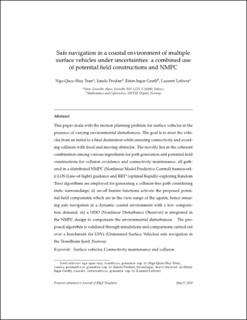| dc.contributor.author | Tran, Ngo-Quoc-Huy | |
| dc.contributor.author | Prodan, Ionela | |
| dc.contributor.author | Grøtli, Esten Ingar | |
| dc.contributor.author | Lefevre, Laurent | |
| dc.date.accessioned | 2023-09-20T10:35:09Z | |
| dc.date.available | 2023-09-20T10:35:09Z | |
| dc.date.created | 2021-02-01T13:42:53Z | |
| dc.date.issued | 2020 | |
| dc.identifier.issn | 0029-8018 | |
| dc.identifier.uri | https://hdl.handle.net/11250/3090772 | |
| dc.description.abstract | This paper deals with the motion planning problem for surface vehicles in the presence of varying environmental disturbances. The goal is to steer the vehicles from an initial to a final destination while ensuring connectivity and avoiding collision with fixed and moving obstacles. The novelty lies in the coherent combination among various ingredients for path generation and potential field constructions for collision avoidance and connectivity maintenance, all gathered in a distributed NMPC (Nonlinear Model Predictive Control) framework: i) LOS (Line-of-Sight) guidance and RRT* (optimal Rapidly-exploring Random Tree) algorithms are employed for generating a collision-free path considering static surroundings; ii) on-off barrier functions activate the proposed potential field components which are in the view range of the agents, hence ensuring safe navigation in a dynamic coastal environment with a low computation demand; iii) a NDO (Nonlinear Disturbance Observer) is integrated in the NMPC design to compensate the environmental disturbances. The proposed algorithm is validated through simulations and comparisons carried out over a benchmark for USVs (Unmanned Surface Vehicles) safe navigation in the Trondheim fjord, Norway. | en_US |
| dc.language.iso | eng | en_US |
| dc.publisher | Elsevier Ltd. | en_US |
| dc.title | Safe navigation in a coastal environment of multiple surface vehicles under uncertainties: A combined use of potential field constructions and NMPC | en_US |
| dc.type | Peer reviewed | en_US |
| dc.type | Journal article | en_US |
| dc.description.version | acceptedVersion | en_US |
| dc.rights.holder | © 2020 Elsevier Ltd. All rights reserved. | en_US |
| dc.source.pagenumber | 56 | en_US |
| dc.source.volume | 216 | en_US |
| dc.source.journal | Ocean Engineering | en_US |
| dc.identifier.doi | https://doi.org/10.1016/j.oceaneng.2020.107706 | |
| dc.identifier.cristin | 1885057 | |
| cristin.ispublished | true | |
| cristin.fulltext | original | |
| cristin.fulltext | postprint | |
| cristin.qualitycode | 1 | |
